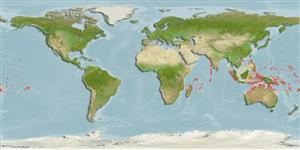>
Blenniiformes (Blennies) >
Blenniidae (Combtooth blennies) > Blenniinae
Etymology: Petroscirtes: Latin, petra, -ae = stone + Greek, skirteo = to jump.
More on authors: Jordan & Seale.
Environment: milieu / climate zone / depth range / distribution range
Ecologia
marino associati a barriera corallina; distribuzione batimetrica 0 - 12 m (Ref. 86942). Tropical; 16°N - 24°S
Indo-Pacific: East Africa to the Line and Society Islands, north to Mariana Islands, south to the southern Great Barrier Reef; throughout Micronesia. Likely at Seychelles (Ref. 1623).
Size / Peso / Age
Maturity: Lm ? range ? - ? cm
Max length : 7.5 cm TL maschio/sesso non determinato; (Ref. 90102)
Short description
Chiavi di identificazione | Morfologia | Morfometria
Spine dorsali (totale) : 10 - 11; Raggi dorsali molli (totale) : 14 - 16. Has a tall dorsal fin and small tufts below the chin (Ref. 48636). Resembles P. thepassii and P. variabilis but usually has fewer total dorsal fin elements (Ref. 37816).
Adults occur solitary (Ref. 90102) usually over sandy areas of reef flats and shallow lagoons. Small juveniles were found below the upside-down jelly Cassiopea that moves over sandy substrates providing safe travel (Ref. 48636). Eggs are attached to the substrate via a filamentous, adhesive pad or pedestal (Ref. 94114). Females nest in empty mollusk shells (Ref. 1602). Larvae are planktonic, often found in shallow, coastal waters (Ref. 94114).
Life cycle and mating behavior
Maturità | Riproduzione | Deposizione | Uova | Fecundity | Larve
Oviparous, distinct pairing (Ref. 205). Nests in empty mollusk shells (Ref. 1602).
Myers, R.F., 1991. Micronesian reef fishes. Second Ed. Coral Graphics, Barrigada, Guam. 298 p. (Ref. 1602)
IUCN Red List Status (Ref. 130435: Version 2024-1)
Threat to humans
Harmless
Human uses
Pesca: commerciale; Acquario: Commerciale
Strumenti
Special reports
Download XML
Fonti Internet
Estimates based on models
Preferred temperature (Ref.
123201): 26.2 - 29.3, mean 28.5 °C (based on 1873 cells).
Phylogenetic diversity index (Ref.
82804): PD
50 = 0.5005 [Uniqueness, from 0.5 = low to 2.0 = high].
Bayesian length-weight: a=0.00575 (0.00253 - 0.01308), b=3.06 (2.86 - 3.26), in cm total length, based on LWR estimates for this (Sub)family-body shape (Ref.
93245).
Trophic level (Ref.
69278): 2.4 ±0.3 se; based on size and trophs of closest relatives
Resilienza (Ref.
120179): Alto, tempo minimo di raddoppiamento della popolazione meno di 15 mesi (Preliminary K or Fecundity.).
Fishing Vulnerability (Ref.
59153): Low vulnerability (10 of 100).
Nutrients (Ref.
124155): Calcium = 200 [96, 354] mg/100g; Iron = 0.967 [0.540, 1.745] mg/100g; Protein = 17.9 [16.6, 19.0] %; Omega3 = 0.0845 [, ] g/100g; Selenium = 22.9 [10.5, 53.5] μg/100g; VitaminA = 114 [28, 474] μg/100g; Zinc = 2.92 [1.87, 4.32] mg/100g (wet weight);
